European Rice
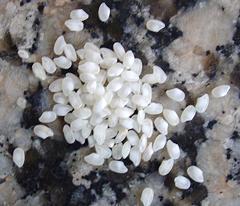 [Oryza sativa var japonica]
[Oryza sativa var japonica]
The best known European rices are from Portugal, Spain and Italy.
France, Greece and the Balkans produce a very small amount of rice for
local consumption.
All significant rice production in Europe is short to medium grain
high amylopectin japonica, both due to cool climate and the popular
methods by which rice is cooked in the region. The rices produced are very
specific to regional cooking methods and are imperfectly interchangeable.
These cooking methods have been adopted by people in North America, and
the correct rice for each should be selected for good results.
Photo by (couldn't relocate) distributed under license
Creative Commons
Attribution-ShareAlike v4.0 International.
General Information on Rice, and rice
of other regions.
Portugal
Portuguese rice dishes unlike the Spanish or Italian, tend to be soupy, with
plenty of liquid. The Portuguese also like their rice creamy, not "al dente".
Traditionalists in Portugal are upset that Carolino rice has been so supplanted
by Agulha rice, and outraged that some restaurants are making traditional
dishes with parboiled rice - not suitable, but more difficult to screw up in
a restaurant kitchen.
|
Carolino Rice
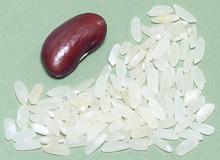 The traditional rice in Portugal is Carolino, a medium grain japonica
type rice. "Aríete" and "Euro" are current cultivars. In recent
times Agulha, a long grain rice has largely displaced it, even though Agulha
is not as suitable for the Portuguese style of rice cooking. Some cooks are
even using parboiled rice, which doesn't work at all well. Effort is
ongoing to restore Carolino rice to popularity and to improve Portugal's
rice cuisine. The photo specimens were 0.275 inch long and 0.095 inch
wide (7.0 x 2.4 mm).
The traditional rice in Portugal is Carolino, a medium grain japonica
type rice. "Aríete" and "Euro" are current cultivars. In recent
times Agulha, a long grain rice has largely displaced it, even though Agulha
is not as suitable for the Portuguese style of rice cooking. Some cooks are
even using parboiled rice, which doesn't work at all well. Effort is
ongoing to restore Carolino rice to popularity and to improve Portugal's
rice cuisine. The photo specimens were 0.275 inch long and 0.095 inch
wide (7.0 x 2.4 mm).
Agulha rice
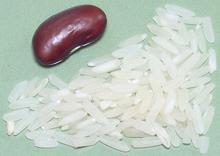 This long grain "needle rice" is currently the most common Portuguese grown
rice, and often used where it shouldn't be. The photo specimens were 0.285
inch long and 0.075 inch wide (7.2 x 1.9 mm). One cup of this rice needs
1-3/4 cups of water and cooks in 25 minutes.
This long grain "needle rice" is currently the most common Portuguese grown
rice, and often used where it shouldn't be. The photo specimens were 0.285
inch long and 0.075 inch wide (7.2 x 1.9 mm). One cup of this rice needs
1-3/4 cups of water and cooks in 25 minutes.
|
Spain
Spain, through which rice entered Europe, cooks it rather differently
from any other place in the world. Paella is named for the pan it
is cooked in, a shallow uncovered pan. This requires a super absorbent
rice, so most rice simply will not do. If Spanish rice is not available,
a risotto rice like Carnaroli can be used
(risotto is of Spanish origin), but the results are not quite the
same.
The Spanish also cook Arroz, which is the same kind of rice
cooked in a cazuela, either in the oven or on the stove top.
Arroz may be dry or very moist. Paella is always dry, in other words,
all the liquid is absorbed by the rice.
|
Bomba
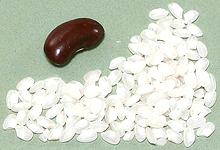 This is considered the best rice for paella. It is relatively expensive
and the package will always advertise Bomba if that's what is in it.
This rice is grown in Murcia and Valencia. One desirable feature of
Bomba is that it is not as easily ruined by overcooking as other
varieties. The normal recommendation for paella is there should be
twice as much broth as rice, but with bomba you may need just a touch
more as it is very absorbent. The grains are tiny, with the photo
specimens typically measuring 0.190 inch long and 0.115 inch wide.
Grown in Valencia, 2014 US $5.99 per 1/2 kilo (1.1 pounds).
This is considered the best rice for paella. It is relatively expensive
and the package will always advertise Bomba if that's what is in it.
This rice is grown in Murcia and Valencia. One desirable feature of
Bomba is that it is not as easily ruined by overcooking as other
varieties. The normal recommendation for paella is there should be
twice as much broth as rice, but with bomba you may need just a touch
more as it is very absorbent. The grains are tiny, with the photo
specimens typically measuring 0.190 inch long and 0.115 inch wide.
Grown in Valencia, 2014 US $5.99 per 1/2 kilo (1.1 pounds).
Valencia
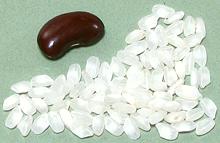 Valencia is the main rice growing region of Spain. Valencia rice is
considered excellent rice for paella. If the package is labeled
"Valencia" it may contain Arroz Fonsa, Gleva, Bahia, or Senia, but
not Bomba, unless Bomba is specified on the label. The general
recommendation for paella is twice as much broth as rice. The photo
specimens were typically 0.233 inch long and 0.129 inch wide. 2014
US $3.79 per kilo (2.2 pounds).
Valencia is the main rice growing region of Spain. Valencia rice is
considered excellent rice for paella. If the package is labeled
"Valencia" it may contain Arroz Fonsa, Gleva, Bahia, or Senia, but
not Bomba, unless Bomba is specified on the label. The general
recommendation for paella is twice as much broth as rice. The photo
specimens were typically 0.233 inch long and 0.129 inch wide. 2014
US $3.79 per kilo (2.2 pounds).
Calasparra
This rice, grown in Murcia, is suitable for paella, but is also
liked for arroz cooked in cazuela because it is more
resistant to overcooking than most varieties.
Delta del Ebro
A rice suitable for paella grown in Tarragona.
|
Italy
The risotto rice category includes a number of Italian varieties, all
medium grain, that absorb a lot of water and develop a creamy outside,
but with a moderately firm core. Do not rinse rice for risotto, the
starch on the outside becomes part of the texture. The three varieties
considered best are Carnaroli, Maratelli and Vialone Nano. The Italians
do use some rice other than risotto varieties, but not a lot.
Risotto is cooked quite differently from most rice dishes. The rice
is first fried very lightly in oil or butter. usually mixed with onions
and other ingredients. It is then cooked with a lot of stirring, with
broth stirred in only as needed - always half the remaining amount until
the last 1/4 cup.
Risotto Rice Designations These are Comune, Semifino,
Fino and Superfino. These designations have no relationship to quality,
they are calculated from the length to width ratio of the grains.
|
Arborio
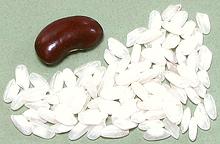 This is a superfino risotto rice, the best known risotto rice outside
Italy, but within Italy it has been displaced by others. It takes
longer to cook than the more popular rice, absorbs less water and
is very cranky, going from under cooked to over cooked "in the blink
of an eye". It is considered unsuitable for restaurant service. The
photo specimens, from Italy, were 0.275 inch long and 0.128 inch wide
(8.4 x 3.9 mm).
This is a superfino risotto rice, the best known risotto rice outside
Italy, but within Italy it has been displaced by others. It takes
longer to cook than the more popular rice, absorbs less water and
is very cranky, going from under cooked to over cooked "in the blink
of an eye". It is considered unsuitable for restaurant service. The
photo specimens, from Italy, were 0.275 inch long and 0.128 inch wide
(8.4 x 3.9 mm).
Baldo
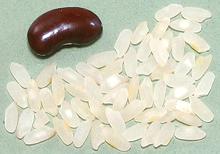 This is an Italian, medium grain rice developed from Arborio crossed
with Stirpe 136 rice and now popular in most Mediterranean countries.
It is particularly favored by restaurants because it holds up better
than Arborio to the practice of partially cooking and then chilling
risottos, to be finish cooked to customer's orders. The photo
specimens, grown in Turkey, were typically 0.285 inch long by 0.122
inch wide (7.2 x 3.1 mm).
This is an Italian, medium grain rice developed from Arborio crossed
with Stirpe 136 rice and now popular in most Mediterranean countries.
It is particularly favored by restaurants because it holds up better
than Arborio to the practice of partially cooking and then chilling
risottos, to be finish cooked to customer's orders. The photo
specimens, grown in Turkey, were typically 0.285 inch long by 0.122
inch wide (7.2 x 3.1 mm).
Carnaroli
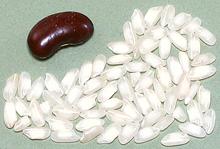 Grown in a small region of northern Italy between Milan and Turin,
Carnaroli is perhaps the most prestigious Italian risotto rice and is
generally reserved for the most refined dishes. Compared to arborio the
grains are larger and while they become exceptionally creamy on the
outside they hold their shape at the core, due to a higher amount
of amylose starch in the center, making for a better texture. The
photo specimens, grown in Argentina, were typically 0.260 inch long
and 0.130 inch wide (6.6 x 3.3 mm).
Grown in a small region of northern Italy between Milan and Turin,
Carnaroli is perhaps the most prestigious Italian risotto rice and is
generally reserved for the most refined dishes. Compared to arborio the
grains are larger and while they become exceptionally creamy on the
outside they hold their shape at the core, due to a higher amount
of amylose starch in the center, making for a better texture. The
photo specimens, grown in Argentina, were typically 0.260 inch long
and 0.130 inch wide (6.6 x 3.3 mm).
Vialone Nano
 This semi-fino rice is one of the most favored risotto rice varieties,
especially in the region around Venice. The photo specimens, from
Italy, were typically 0.230 inch long and 0.135 inch wide
(6.6 x 3.3).
This semi-fino rice is one of the most favored risotto rice varieties,
especially in the region around Venice. The photo specimens, from
Italy, were typically 0.230 inch long and 0.135 inch wide
(6.6 x 3.3).
Other Risotto Rice Varieties
- Maratelli This is an early ripening variety with
heavy yield. It is somewhat higher in amylose starch than other
risotto rice so the grains (similar to Carnaroli) stay a bit more
separate in risottos.
- Padano
- Piedmont Rice another name for Risotto Rice.
- Roma
Nero Venere
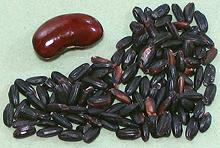 This is not a risotto rice, but has become popular as a color contrast,
particularly served with green vegetables. This medium grain rice is
grown in the Padana Delta of the Po River in northern Italy, just a bit
south of Venice. It was developed as a hybrid of the
China Black rice. Hybridization
was necessary because the original China Black rice could not withstand
the colder winters of the Po Valley, but the result is very much like
the Chinese parent. The photo specimens, purchased from a local Italian
market in Los Angeles, were typically 0.235 inches long by 0.107 inch
wide (6.0 x 2.7 mm). A cup of this rice needs about 2-1/4 cups of water
and about 55 minutes of cooking to make about 3 cups. The grains remain
quite firm and very separate, with a pleasant flavor and deep color.
This is not a risotto rice, but has become popular as a color contrast,
particularly served with green vegetables. This medium grain rice is
grown in the Padana Delta of the Po River in northern Italy, just a bit
south of Venice. It was developed as a hybrid of the
China Black rice. Hybridization
was necessary because the original China Black rice could not withstand
the colder winters of the Po Valley, but the result is very much like
the Chinese parent. The photo specimens, purchased from a local Italian
market in Los Angeles, were typically 0.235 inches long by 0.107 inch
wide (6.0 x 2.7 mm). A cup of this rice needs about 2-1/4 cups of water
and about 55 minutes of cooking to make about 3 cups. The grains remain
quite firm and very separate, with a pleasant flavor and deep color.
|
ri_euroz 060510 r 140115 r 210916 - www.clovegarden.com
©Andrew Grygus - agryg@clovegarden.com - Photos
on this page not otherwise credited © cg1
- Linking to and non-commercial use of this page permitted
 The traditional rice in Portugal is Carolino, a medium grain japonica
type rice. "Aríete" and "Euro" are current cultivars. In recent
times Agulha, a long grain rice has largely displaced it, even though Agulha
is not as suitable for the Portuguese style of rice cooking. Some cooks are
even using parboiled rice, which doesn't work at all well. Effort is
ongoing to restore Carolino rice to popularity and to improve Portugal's
rice cuisine. The photo specimens were 0.275 inch long and 0.095 inch
wide (7.0 x 2.4 mm).
The traditional rice in Portugal is Carolino, a medium grain japonica
type rice. "Aríete" and "Euro" are current cultivars. In recent
times Agulha, a long grain rice has largely displaced it, even though Agulha
is not as suitable for the Portuguese style of rice cooking. Some cooks are
even using parboiled rice, which doesn't work at all well. Effort is
ongoing to restore Carolino rice to popularity and to improve Portugal's
rice cuisine. The photo specimens were 0.275 inch long and 0.095 inch
wide (7.0 x 2.4 mm).
 This long grain "needle rice" is currently the most common Portuguese grown
rice, and often used where it shouldn't be. The photo specimens were 0.285
inch long and 0.075 inch wide (7.2 x 1.9 mm). One cup of this rice needs
1-3/4 cups of water and cooks in 25 minutes.
This long grain "needle rice" is currently the most common Portuguese grown
rice, and often used where it shouldn't be. The photo specimens were 0.285
inch long and 0.075 inch wide (7.2 x 1.9 mm). One cup of this rice needs
1-3/4 cups of water and cooks in 25 minutes.
 [Oryza sativa var japonica]
[Oryza sativa var japonica]
 This is considered the best rice for paella. It is relatively expensive
and the package will always advertise Bomba if that's what is in it.
This rice is grown in Murcia and Valencia. One desirable feature of
Bomba is that it is not as easily ruined by overcooking as other
varieties. The normal recommendation for paella is there should be
twice as much broth as rice, but with bomba you may need just a touch
more as it is very absorbent. The grains are tiny, with the photo
specimens typically measuring 0.190 inch long and 0.115 inch wide.
Grown in Valencia, 2014 US $5.99 per 1/2 kilo (1.1 pounds).
This is considered the best rice for paella. It is relatively expensive
and the package will always advertise Bomba if that's what is in it.
This rice is grown in Murcia and Valencia. One desirable feature of
Bomba is that it is not as easily ruined by overcooking as other
varieties. The normal recommendation for paella is there should be
twice as much broth as rice, but with bomba you may need just a touch
more as it is very absorbent. The grains are tiny, with the photo
specimens typically measuring 0.190 inch long and 0.115 inch wide.
Grown in Valencia, 2014 US $5.99 per 1/2 kilo (1.1 pounds).
 Valencia is the main rice growing region of Spain. Valencia rice is
considered excellent rice for paella. If the package is labeled
"Valencia" it may contain Arroz Fonsa, Gleva, Bahia, or Senia, but
not Bomba, unless Bomba is specified on the label. The general
recommendation for paella is twice as much broth as rice. The photo
specimens were typically 0.233 inch long and 0.129 inch wide. 2014
US $3.79 per kilo (2.2 pounds).
Valencia is the main rice growing region of Spain. Valencia rice is
considered excellent rice for paella. If the package is labeled
"Valencia" it may contain Arroz Fonsa, Gleva, Bahia, or Senia, but
not Bomba, unless Bomba is specified on the label. The general
recommendation for paella is twice as much broth as rice. The photo
specimens were typically 0.233 inch long and 0.129 inch wide. 2014
US $3.79 per kilo (2.2 pounds).
 This is a superfino risotto rice, the best known risotto rice outside
Italy, but within Italy it has been displaced by others. It takes
longer to cook than the more popular rice, absorbs less water and
is very cranky, going from under cooked to over cooked "in the blink
of an eye". It is considered unsuitable for restaurant service. The
photo specimens, from Italy, were 0.275 inch long and 0.128 inch wide
(8.4 x 3.9 mm).
This is a superfino risotto rice, the best known risotto rice outside
Italy, but within Italy it has been displaced by others. It takes
longer to cook than the more popular rice, absorbs less water and
is very cranky, going from under cooked to over cooked "in the blink
of an eye". It is considered unsuitable for restaurant service. The
photo specimens, from Italy, were 0.275 inch long and 0.128 inch wide
(8.4 x 3.9 mm).
 This is an Italian, medium grain rice developed from Arborio crossed
with Stirpe 136 rice and now popular in most Mediterranean countries.
It is particularly favored by restaurants because it holds up better
than Arborio to the practice of partially cooking and then chilling
risottos, to be finish cooked to customer's orders. The photo
specimens, grown in Turkey, were typically 0.285 inch long by 0.122
inch wide (7.2 x 3.1 mm).
This is an Italian, medium grain rice developed from Arborio crossed
with Stirpe 136 rice and now popular in most Mediterranean countries.
It is particularly favored by restaurants because it holds up better
than Arborio to the practice of partially cooking and then chilling
risottos, to be finish cooked to customer's orders. The photo
specimens, grown in Turkey, were typically 0.285 inch long by 0.122
inch wide (7.2 x 3.1 mm).
 Grown in a small region of northern Italy between Milan and Turin,
Carnaroli is perhaps the most prestigious Italian risotto rice and is
generally reserved for the most refined dishes. Compared to arborio the
grains are larger and while they become exceptionally creamy on the
outside they hold their shape at the core, due to a higher amount
of amylose starch in the center, making for a better texture. The
photo specimens, grown in Argentina, were typically 0.260 inch long
and 0.130 inch wide (6.6 x 3.3 mm).
Grown in a small region of northern Italy between Milan and Turin,
Carnaroli is perhaps the most prestigious Italian risotto rice and is
generally reserved for the most refined dishes. Compared to arborio the
grains are larger and while they become exceptionally creamy on the
outside they hold their shape at the core, due to a higher amount
of amylose starch in the center, making for a better texture. The
photo specimens, grown in Argentina, were typically 0.260 inch long
and 0.130 inch wide (6.6 x 3.3 mm).
 This semi-fino rice is one of the most favored risotto rice varieties,
especially in the region around Venice. The photo specimens, from
Italy, were typically 0.230 inch long and 0.135 inch wide
(6.6 x 3.3).
This semi-fino rice is one of the most favored risotto rice varieties,
especially in the region around Venice. The photo specimens, from
Italy, were typically 0.230 inch long and 0.135 inch wide
(6.6 x 3.3).
 This is not a risotto rice, but has become popular as a color contrast,
particularly served with green vegetables. This medium grain rice is
grown in the Padana Delta of the Po River in northern Italy, just a bit
south of Venice. It was developed as a hybrid of the
This is not a risotto rice, but has become popular as a color contrast,
particularly served with green vegetables. This medium grain rice is
grown in the Padana Delta of the Po River in northern Italy, just a bit
south of Venice. It was developed as a hybrid of the